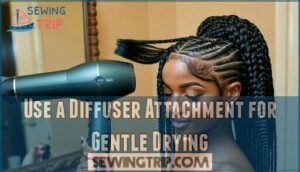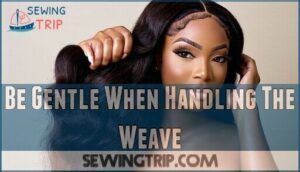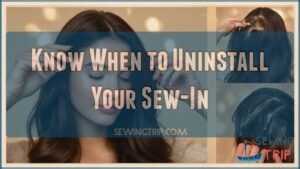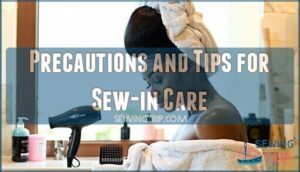This site is supported by our readers. We may earn a commission, at no cost to you, if you purchase through links.
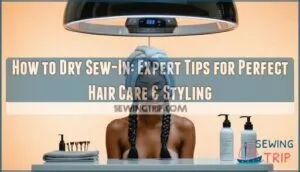
Part the weave sections to expose your braids underneath, then use a blow dryer on cool-to-medium heat, keeping it moving to avoid heat damage.
Don’t rush this process; wet braids trapped under weave can develop that funky smell nobody wants.
For best results, sit under a hooded dryer for 30-45 minutes, ensuring everything’s bone dry, with proper airflow and patience, as the key is to allow your hair to dry completely, and your hair will thank you, because perfect drying technique sets the foundation for everything else.
Table Of Contents
- Key Takeaways
- Dry Your Sew-in After Washing
- Alternative Drying Methods for Sew-Ins
- Properly Moisturize Your Scalp
- Styling Tips for Your Sew-In
- Establish a Weekly Wash Routine
- Know When to Uninstall Your Sew-In
- Precautions and Tips for Sew-in Care
- Proper Care for Your Real Hair Underneath
- Addressing Mildew-Like Smell
- Frequently Asked Questions (FAQs)
- Conclusion
Key Takeaways
- Part your weave sections to expose the braids underneath and allow proper airflow – this prevents trapped moisture that leads to mildew and funky odors
- Use a hooded dryer for 30-45 minutes instead of relying on air drying alone, as wet braids underneath can develop bacterial growth if they do not dry completely
- Keep your blow dryer moving constantly on low-to-medium heat settings and maintain a 6-8 inch distance to avoid heat damage while ensuring thorough drying
- Do not rush the process – patience is key since incomplete drying creates the perfect breeding ground for bacteria and can compromise your scalp health
Dry Your Sew-in After Washing
Properly drying your sew-in after washing is essential for maintaining healthy hair and preventing mildew odors that can develop when moisture gets trapped in the braids underneath.
You’ll need to use specific techniques and tools to guarantee both your extensions and natural hair dry completely while avoiding heat damage.
Detangle Before Drying
Mastering the art of gentle detangling transforms your sew-in care routine from potential disaster to hair heaven. Start with patience—your braids deserve respect, not rushed tugging that leads to breakage.
- Use a wide-tooth comb: Start from ends, working upward to prevent snags
- Apply leave-in conditioner: Creates slip for easier hair combing and braid care
- Work in small sections: Prevents overwhelming tangles in your sew in hair
- Try finger detangling first: Gentle approach before using any combing tools
- Take your time: Rushing leads to breakage—soft brushing wins every time
Part The Weave to Allow Airflow
Smart airflow techniques start with strategic weave parting—create sections throughout your sew in weave to boost hair ventilation.
Part the weave horizontally every few inches, allowing air to reach the braids underneath.
This simple weave parting method prevents trapped moisture and speeds up braid drying while maintaining your hair weaving structure intact.
Use a Handheld Blow Dryer
After parting your weave for proper airflow, you’ll grab your handheld blow dryer to tackle the drying process. Set that dryer to low heat settings – your hair protection depends on it.
Moving the dryer continuously prevents concentrated heat damage while guaranteeing gentle drying throughout your sew-in.
Here’s your blow dry playbook:
- Keep distance: Hold the dryer 6-8 inches away from your scalp
- Section smartly: Pin up hair layers to reach underlying braids effectively
- Move constantly: Never let heat concentrate in one spot
- Check progress: Pat test braid roots to confirm they’re completely dry
These dryer techniques transform your hair drying routine from guesswork into precision. Your handheld blow dryer becomes a targeted tool when you focus airflow along braid roots rather than randomly waving it around.
Remember, patience wins – rushing leads to heat damage that’ll haunt your dry weave later. To maintain healthy hair, understanding sew in removal techniques is also vital for overall hair care.
Avoid Direct Contact With The Hair
While blow drying your sew in extensions, maintaining proper distance prevents heat damage.
Hold your dryer 6-8 inches away from hair strands.
This technique protects both your natural hair and the weave from concentrated heat exposure.
| Heat Setting | Distance Required |
|---|---|
| Low Heat Settings | 6-8 inches |
| Medium Heat | 8-10 inches |
| Cool Setting | 4-6 inches |
Use Gentle Blotting with Microfiber Towels first to remove excess moisture.
Apply Heat Protectors before styling, then attach Diffuser Attachments for even heat distribution.
This dry sew in method guarantees your sew in method stays healthy while achieving perfect results for your dry sewn hair.
Alternative Drying Methods for Sew-Ins
While traditional air drying works, you’ll need faster alternatives that properly protect your investment from damage and mildew.
These professional-grade methods guarantee your sew-in stays fresh and healthy, and styled to perfection every time.
Invest in Dry Shampoo & a Blow Dryer
Quality hair tools make maintaining your sew-in effortless between washes.
Dry shampoo effectively absorbs oil from both natural hair and extensions, extending time between traditional washing sessions.
A reliable blow dryer with adjustable settings speeds up the drying process while preventing mildew formation. Choose gentle formulas and low heat settings to protect your investment.
Using the right dry shampoo products can make a significant difference in hair care and styling with the right dry shampoo products.
Consider Using a Bonnet or Hooded Dryer
When you need faster results than air drying, bonnet dryers and hooded heating systems deliver gentle drying without the harsh blast of direct blow drying.
These dome-shaped tools create controlled airflow management around your entire head, ensuring even heat distribution at low temperatures.
Here’s why they’re game-changers for your drying techniques:
- Bonnet dryers attach to your blow dryer, creating a soft heat bubble
- Hooded heating units provide hands-free operation for 30-45 minutes
- Gentle drying prevents the frizz and damage from concentrated heat
This method beats air drying’s lengthy process while protecting your investment from heat damage.
Using a bonnet hair dryer can be an effective way to achieve salon-quality results at home.
Use a Diffuser Attachment for Gentle Drying
When using a diffuser attachment for gentle drying, you’ll protect your natural hair underneath while achieving professional results.
This game-changing tool transforms harsh airflow into a soft, even distribution that won’t damage your precious braids.
- Gentle Heat: Disperses warm air evenly across all braided sections without concentrated hot spots
- Frizz Control: Maintains your hair’s natural texture while reducing unwanted puffiness and flyaways
- Hair Protection: Shields delicate strands from direct heat exposure that can cause breakage
- Versatile Positioning: Allows you to angle airflow precisely where needed without rough handling
- Enhanced Drying: Guarantees thorough moisture removal from hard-to-reach areas beneath your sew-in
The diffuser attachment revolutionizes your drying techniques by creating controlled airflow that respects your hair’s structure.
Unlike traditional blow-drying methods, this approach gives you complete mastery over the process while delivering consistent results every time.
Properly Moisturize Your Scalp
After proper drying, you’ll need to maintain scalp health to prevent irritation and promote healthy hair growth beneath your sew-in.
Moisturizing your scalp and the underlying braids keeps everything fresh and prevents the dreaded itchy, flaky scalp that can ruin your protective style, which is crucial for healthy hair growth.
Apply Tonic or Oil to The Scalp
Proper scalp care starts with choosing between scalp oil or scalp tonic for your hair sew in.
Apply your chosen product directly to your scalp using an applicator bottle for precise sewin maintenance.
Scalp massage during tonic application promotes hair growth while oil benefits include deep moisture.
This scalp health routine prevents dryness and irritation underneath your weave, ensuring ideal scalp care throughout your protective style journey.
Using a hair tonic product can provide additional benefits for scalp health and hair growth.
Section Hair and Massage Product In
Divide your hair into manageable sections using your fingers to create clear parts.
Apply the tonic or oil systematically to each section, ensuring complete scalp coverage.
Use gentle circular massage techniques with your fingertips to work the product into your scalp.
This methodical approach to hair sectioning and product application promotes ideal scalp health and hair moisture retention, making your sew in technique more effective for long-term hair care.
Focus on The Braids Underneath The Weave
Pay special attention to those hidden braids beneath your weave—they’re the foundation of your entire sew in technique.
These underlying braids trap moisture more easily, making thorough braid care essential for weave maintenance.
Gently work your scalp protection products through each braid, ensuring complete coverage, to prevent odor and support hair health.
Styling Tips for Your Sew-In
Once you’ve properly dried your sew-in, styling it correctly guarantees your investment lasts longer and looks flawless every day.
The key is treating your weave like your natural hair—with care, protection, and the right techniques to avoid damage.
Use a Heat Protectant Before Styling
Every smart stylist knows that heat protection stands as your first line of defense against styling damage.
Apply heat protectant generously throughout your hair before reaching for any styling tools, creating an invisible shield that prevents frizz control issues and thermal damage.
This hair serum forms a protective barrier between your hair extension and hot tools, maintaining your styles’ integrity.
Focus thermal care on mid-lengths and ends where damage occurs most frequently.
Your drying techniques become more effective when combined with proper heat protection, ensuring your styling tips deliver salon-quality results every time.
To achieve the best results, understanding sew in styles is vital for maintaining healthy and beautiful hair.
Be Gentle When Handling The Weave
Gentle handling transforms your weave care routine from potential disaster to hair protection success.
Your hands become the ultimate tools for braid maintenance and scalp health when you master these techniques:
- Hold sections at the root while brushing to minimize tension on underlying braids
- Use fingertips instead of nails when parting or styling your weave hair
- Support wefts with one hand while detangling with the other during dry sewing maintenance
- Avoid aggressive pulling when creating sew in styles or updos
- Gently lift and separate layers rather than forcing through tangles during weave sewing
These techniques are crucial for maintaining the health and integrity of your weave, and by following them, you can ensure a successful and stress-free hair care routine.
By mastering gentle handling and these specific techniques, you can prevent potential damage and promote overall scalp health.
Avoid Excessive Heat and Styling Tools
Three daily heat styling sessions can spell disaster for your sew-in’s longevity.
Excessive heat from flat irons and curling tools strips moisture, causing heat damage and weakening both extensions and natural hair underneath.
Embrace air drying whenever possible, using heat protectant before any styling.
When you must use heat tools, stick to low heat settings and gentle handling techniques.
Try heat-free alternatives like twist-outs, braids, or roller sets.
Your hair protection strategy should prioritize styling tips that maintain moisture while preventing heat damage through mindful blow drying practices.
Establish a Weekly Wash Routine
Establishing a consistent weekly washing routine keeps your sew-in fresh and extends its lifespan substantially.
You’ll want to focus on three key steps: shampooing your scalp thoroughly, conditioning the weave properly, and rinsing completely to prevent product buildup that can weigh down your hair.
Shampoo and Massage The Scalp
After each wash session, apply gentle shampoo using circular massage techniques to stimulate scalp health.
Use your fingertips to work sulfate-free formulas through sections, targeting braids underneath your sew in care routine.
This scalp massage promotes circulation while hair oils distribute naturally.
Focus on hairline and nape areas where buildup accumulates, ensuring thorough cleansing for ideal hair care results.
Condition and Untangle The Weave
After shampooing, apply hydrating conditioner from mid-lengths to ends, avoiding roots to prevent buildup.
Work through your weave with a wide-tooth comb, starting at the tips and moving upward. This hair conditioning technique prevents tangle removal struggles later.
Focus on moisturizing each section thoroughly—your sewin hair extensions deserve the same love as your natural hair. Gentle combing with softening products keeps everything manageable.
Rinse Thoroughly to Prevent Buildup
Follow up with thorough water removal using lukewarm temperatures to eliminate every trace of conditioner from your sewin hair extensions. Incomplete gentle rinsing creates the perfect storm for buildup prevention failure, leading to scalp health issues and irritation.
Use an applicator bottle for precise washing techniques, targeting hard-to-reach areas where residue loves to hide.
Hair porosity affects how quickly your hair extension washing process should proceed.
Pat braids gently with a microfiber towel, then apply lightweight moisturizer before final drying to maintain ideal condition.
Know When to Uninstall Your Sew-In
Knowing when to remove your sew-in is essential for maintaining healthy natural hair underneath.
You’ll want to uninstall your weave after 6 to 8 weeks, as keeping it longer can lead to matting, breakage, and potential scalp issues, which makes removing it a crucial step for preventing breakage.
Remove The Weave After 6 to 8 Weeks
Your sew-in’s extension lifespan maxes out at eight weeks—pushing beyond this timeline invites hair breakage and compromised scalp health.
Professional removal becomes essential as loosened tracks and matted growth signal it’s time for weave removal.
Proper hair weave uninstallation prevents damage, while timely sewin maintenance protects your natural hair underneath for ideal post removal care results.
Give Your Natural Hair a Break
After removing your sewin, your natural hair needs proper recovery time.
This Hair Break allows your scalp to heal and prevents damage from continuous tension. Give your strands 2-4 weeks to restore their strength before your next installation.
- Scalp Health restoration – Let follicles recover from braiding tension
- Hair Recovery treatments – Deep condition weekly for maximum moisture
- Gentle Handling practices – Use wide-tooth combs and minimal manipulation
- Natural Rest period – Allow hair extensions breaks to prevent breakage
This Natural Rest phase strengthens your foundation for future hair drying methods.
Seek Professional Help for Removal
Professional hair weave removal requires expert hands to prevent hair damage during extension removal.
Don’t attempt DIY hair weave uninstallation—you’ll risk breaking your natural strands and damaging your scalp.
Professional hair care specialists understand proper techniques for gentle hair weave professional removal.
They’ll carefully cut threads and slide tracks out without tugging.
Your stylist guarantees thorough scalp care throughout the process, then provides aftercare tips to keep your natural hair healthy before your next installation, ensuring a healthy outcome.
Precautions and Tips for Sew-in Care
Proper precautions keep your sew-in looking fresh while protecting your natural hair underneath.
Following these essential tips prevents common issues like product buildup, edge damage, and premature loosening that can ruin your investment, which is why proper precautions are crucial.
Use a Net When Getting a Sew-In
Opting for a net installation transforms your sew-in experience by creating ideal airflow around your scalp.
This smart choice prevents the dreaded mildew smell while making maintenance substantially easier.
Here are the key net benefits for your hair sew-in:
- Enhanced breathability – Hair nets allow air circulation, preventing moisture buildup that causes odor and scalp irritation
- Simplified cleaning – You’ll easily reach your scalp through the mesh for thorough cleansing without disturbing the weave structure
- Extended wear time – Net weave installations typically last longer since your natural hair stays healthier underneath
Avoid Overusing Products on Your Weave
Balance is everything in the context of product application.
Too much product creates buildup that weighs down your weave and dulls its shine. You’ll risk scalp irritation and hair breakage from clogged follicles.
| Problem | Solution |
|---|---|
| Product Buildup | Use quarter-sized amounts |
| Weave Damage | Focus on ends, not roots |
| Scalp Irritation | Dilute heavy products |
| Extension Care | Less is always more |
Lay Down Your Baby Hairs and Edges
After perfecting your sew-in style, it’s time to frame your face beautifully.
Use a rat-tail comb to part baby hair precisely, then apply edge control or hair gel with a small brush for sleek results.
Work the product through each section systematically, smoothing edges against your scalp.
This finishing touch transforms your hair extensions from good to gorgeous, giving your sew-ins that polished, professional appearance that makes heads turn.
To maintain healthy hairlines, consider implementing proper edge care techniques into your daily routine, such as those found at edge care techniques, to ensure the longevity of your style.
Sleep With a Silk Scarf or Bonnet
Protecting your sew-in during sleep is just as important as daytime care.
Wrap your hair in a silk scarf or slip on a bonnet before bed to maintain hair weave moisture and prevent tangles.
The smooth silk fabric reduces friction against your pillow, keeping your hair extension drying process intact.
Consider a silk pillowcase as backup protection for your nighttime care routine.
Proper Care for Your Real Hair Underneath
Caring for your natural hair underneath a sew-in requires the same attention you’d give your extensions.
You’ll need to wash both your real hair and the weave together, using gentle techniques to prevent damage to the braided foundation that holds everything in place, which is crucial for the health of your natural hair.
Wash Your Real Hair and The Weave
After protecting your sew-in at night, it’s time to focus on hair washing and weave care.
Keep scalp health and hair hydration in check by following this wash routine:
- Mix sulfate-free shampoo with water for targeted scalp cleansing.
- Gently massage and rinse, letting water flow downward.
- Apply conditioner, focusing on mid-lengths and ends.
Using a sulfate free shampoo is essential for maintaining healthy hair. Master hair weave maintenance—your scalp will thank you!
Be Gentle When Handling and Detangling
Through careful handling, you’ll protect your hair sewn into protective braids while maintaining extension longevity.
Gentle handling prevents breakage during detangling sessions. Start with wide-tooth combs, working from ends upward. Apply leave-in conditioner for slip before brushing. Use minimal tugging motions to preserve both natural hair and sewins during hair extension maintenance routines.
Regular sew in maintenance is essential for the overall health and appearance of your hair.
| Detangling Step | Technique |
|---|---|
| Start Position | Begin at hair ends, never roots |
| Tool Selection | Wide-tooth comb or detangling brush |
| Product Application | Apply leave-in conditioner for slip |
| Movement Pattern | Work upward with gentle, short strokes |
Use Diluted Products for a Net Weave
While gentle handling matters, net weave maintenance requires specific product dilution techniques to prevent buildup and preserve hair porosity.
When working with a net weave, you’ll want to dilute your shampoo and conditioner at a 1:3 ratio with water before application. This gentle cleansing approach prevents product accumulation that can weigh down your sew in and compromise weave maintenance.
Here’s your product dilution game plan:
- Mix sulfate free shampoo with water – Your scalp will thank you later
- Apply diluted conditioner to mid-lengths only – Skip those roots completely
- Use lightweight oils sparingly – Less is definitely more here
- Focus cleansing on your natural scalp – That’s where the magic happens
- Rinse thoroughly with lukewarm water – No shortcuts allowed
Remember, your hair extension needs breathing room to maintain its longevity and prevent that dreaded matted mess.
Addressing Mildew-Like Smell
That unpleasant mildew smell means moisture got trapped in your braids underneath the sew-in, creating the perfect breeding ground for bacteria.
You’ll need to take immediate action to eliminate this odor and prevent scalp irritation or infection.
Ensure Braids Underneath Are Completely Dry
Mildew prevention starts with proper braid drying techniques after every wash.
You’ll need to sit under a hooded dryer for 30-45 minutes, ensuring complete moisture removal from your scalp and braids.
Low heat settings protect your hair while maintaining adequate dry time.
Air flow is essential—section and pin up hair to expose braids underneath.
Skip this step, and you’re inviting funky odors that’ll have you reaching for the nearest window.
Proper hair drying methods and consistent scalp health practices keep your weave fresh and mildew-free.
Combat Smell by Allowing Hair to Air Dry
Beat that funky smell with proper air drying techniques that create the perfect moisture balance for your sew-in.
Air Dry Tips work best when you’re patient with the process.
- Wash and rinse thoroughly to remove all product buildup
- Gently squeeze out excess water using a microfiber towel
- Blot braids carefully to absorb moisture without disrupting tracks
- Allow complete air drying before any heat styling or manipulation
This mildew prevention method maintains proper scalp hydration while eliminating trapped moisture that causes hair odor.
Seek Professional Help if Smell Persists
When air drying doesn’t eliminate that stubborn hair smell, professional advice becomes your best weapon against persistent mildew odor.
Your stylist can diagnose the root cause and recommend targeted scalp treatment options that home remedies can’t match.
They might suggest specialized clarifying shampoos, deep-cleansing treatments, or antifungal solutions designed for odor elimination.
Don’t suffer in silence—professional intervention prevents minor hair odor issues from becoming major scalp problems.
Sometimes mildew prevention requires expert-level products and techniques that only trained stylists know how to apply safely and effectively for lasting results.
Frequently Asked Questions (FAQs)
How do you Dry a sew-in Braid?
Picture your freshly washed sew-in like a delicate garden after morning rain—every strand needs proper airflow to thrive.
You’ll want to gently squeeze out excess water with a microfiber towel, then sit under a hooded dryer for thirty to forty-five minutes, ensuring those underneath braids dry completely to prevent mildew and maintain healthy hair.
How do you Dry braids under a hooded dryer?
Sit under your hooded dryer for 30-45 minutes, applying heat protectant first.
Section and clip hair up so warm air reaches underlying braids directly.
Verify complete dryness to prevent mildew and scalp irritation.
Do I need to blow dry my weave?
Yes, you should blow dry your weave to prevent mildew and scalp irritation.
Use a hooded dryer for 30-45 minutes or a handheld dryer on low heat with continuous movement to guarantee complete drying.
How often should I wash my sew-in?
Back in your grandmother’s day, she’d tell you to wash weekly, but modern sew-ins need cleansing every 1-2 weeks depending on your scalp’s oil production and activity level.
This keeps your investment fresh without overdoing it.
Do sew-ins dry out your scalp?
Sew-ins won’t necessarily dry out your scalp, but they can if you’re not moisturizing regularly.
Apply lightweight leave-in conditioner or scalp tonic weekly to keep your scalp hydrated and healthy underneath.
How do I Keep my sew-in hair healthy?
Don’t let your sew-in become a science experiment growing mysterious fungi.
Keep it healthy by washing weekly with sulfate-free shampoo, moisturizing regularly with lightweight oils.
Completely drying underneath braids using a hooded dryer to prevent mildew and maintain scalp health.
Can I let my sew in air dry?
Air drying your sew-in works, but you’re risking trouble.
While your extensions can handle it, those braids underneath need complete drying to prevent mildew and scalp irritation.
Use a hooded dryer for safety.
Can I get in the water with a sew in?
Yes, you can get in water with a sew-in, but you’ll need proper preparation and aftercare.
Wet your hair gradually, avoid harsh water pressure, and most importantly—dry those braids completely afterward using a hooded dryer to prevent mildew and scalp issues, which requires complete drying.
How to moisturize your scalp with a sew-in?
Think of your scalp as parched earth craving nourishment—it needs regular care beneath those protective tracks.
Part your sew-in sections carefully, then apply lightweight scalp tonic or diluted leave-in conditioner directly to exposed braids using fingertips or applicator bottle for targeted moisture distribution.
Can you sleep with wet sew-ins?
Sleeping with wet sew-ins isn’t wise—you’ll risk mildew, funky odors, and scalp irritation. Always dry your braids completely using a hooded dryer before hitting the pillow tonight.
Conclusion
Mastering how to dry sew in properly prevents countless hair disasters down the road.
You’ve learned that patience beats rushing every single time—wet braids create funky smells that’ll clear a room faster than burnt popcorn.
Remember to part those weave sections, keep that blow dryer moving, and never skip the hooded dryer step.
Your natural hair deserves this level of care, and with these techniques, you’ll maintain healthy hair that looks salon-fresh for weeks.
- https://beaudee.net/sew-in-weft-hair-extensions-aftercare/
- https://www.reddit.com/r/BlackHair/comments/1lnryzi/how_to_wash_your_sew_in_weave_a_summer_weave_wash/
- https://tarahair.com/blogs/news/can-i-wash-my-hair-with-sew-in-extensions-tips-for-stunning-results
- https://www.unice.com/blog/how-long-does-a-sew-in-last/
- https://usahair.com/blog/common-mistakes-to-avoid-with-sew-in-hair-extensions-essential-tips-for-success.html


